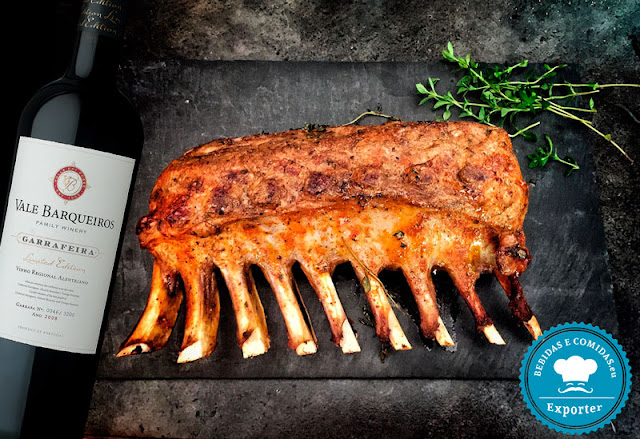Red wine Premium Reserve (Limited Edition) 2008
The red wine premium reserve from the Alentejo region
Portuguese red wine from the outstanding region of the Alentejo.For me it’s easy to write about the Alentejo. Why? Because I’m an “Alentejo lover”.
For loving this Portuguese region so much I'm even suspicious, for praising both the wines and food of my Alentejo.
And I don’t forget the wonderful people, calm and unruffled folk, immensely proud of their homeland. The region of the Alentejo It’s immense with undulating plains, huge skies of the deepest blue and its infinite horizon.
In the vast vineyard the wine grapes Cabernet Sauvignon, Touriga Nacional and Alicante Bouschet grown, were hand picking and then vinified in the cellar to give us this fantastic red wine premium reserve, from 2008, and limited to 3.300 bottles of 0.75ml.
This is the wine that the producer held in the cellar for friends and for special occasions.
At the first look we have one powerful red garnet color.
Second we find one aroma complex and deep wild plums jam with spices. Soft scents of vanilla induced by the French oak barrels.
In the palate is elegant, distinct and complex with long persistent.
We recommend that this red wine will be sip at one temperature between 16° to 17°C.
The red wine premium reserve should be uncorked 2-3 hours before serving.
Please enjoy it with red meats grilled and baked in the oven.
ABV: 14.5% Vol.
Classification: Vinho Regional Alentejano
Type: Red / Premium Reserve
Viticulture
Harvest: 2008
Varieties: Cabernet Sauvignon, Touriga Nacional and Alicante Bouschet
Region: North Alentejo - Portugal
Soil type: Granite derived
Climate: Mediterranean
Harvest
Date: September of 2008
Type: Manual/Hand picking
Vinification
Fermentation: Stainless steel tanks with controlled temperature
Maturation: Twelve months in French oak barrels followed by 1 year on the bottle
The Grapes
CABERNET SAUVIGNONCabernet Sauvignon is the most international of all French grape varieties, being widely grown across all five continents.
It has found a special niche and style in the Alentejo, one of the few Portuguese winegrowing regions where it can ripen to perfection.
Cabernet Sauvignon is one of those varieties that can be termed "enriching"; deeply coloured and thick-skinned, it can spice up blends, imbuing body and consistency to well-composed, perfumed, fruity and spicy wines.
It is rarely bottled as a varietal wine in the Alentejo, but is present in small amounts to give structure in many regional Alentejo wines.
Appreciated for its versatility, resistance and correctness it yields wines of immense longevity that age with elegance and security.
TOURIGA NACIONAL
If ever an indigenous grape variety had to be chosen to represent Portuguese wines, Touriga Nacional would be the one flying the flag.
It flourished for generations in the Dão and Douro regions until the arrival of the dreaded Phylloxera invasion. It then fell from the pinnacle of fame to virtual outcast, no longer planted because of its low yields and frequent millerandage. However, more recent attempts at a comeback have been a total success, and clonal selection has elevated Touriga Nacional once again to centre stage in Portuguese viticulture.
Nowadays Touriga Nacional is heralded throughout Portugal and abroad, earning a place in vineyards in Spain, Australia, South Africa and California.
Dão and Douro have reclaimed paternity of Touriga Nacional, where it is also known as Preto Mortágua, Mortágua, Tourigo Antigo and Tourigo.
The grape's thick skin helps to obtain deep, dense colour - one of the variety's distinctive traits - but it is the abundance and depth of aromas that best identify its value. These may be floral, or fruity, or citrus but they are always intense and explosive, with an urbane, noble air.
ALICANTE BOUSCHET
Despite not being an indigenous Portuguese grape variety, Alicante Bouschet is so deep-rooted in Alentejo collective patrimony that it is often assumed to be Portuguese. In fact it is a displaced variety, the result of conjoining the French varieties Petit Bouschet and Grenache.
It is one of the world's very few colouring grapes, able to provide concentrated, deeply coloured wines, a feature that has earned it the nickname "Writing Ink".
Alicante Bouschet's natural habitat has always been the Alentejo. Introduced here over one hundred years ago by the Reynolds family.
Its many wine attributes include structure, firmness, tannins ... and colour, lots and lots of colour! Alicante Bouschet is seldom bottled as a varietal wine, reinforcing its image as a rustic, structuring grape that could produce pungent and extraordinary wines.
It does wonders to a blend, adding colour, vigour and volume, as so many Alentejo wines will attest to.
The aromas it evokes are of forest berries, cocoa, olives and vegetal notes. Alicante Bouschet is assuredly our most Portuguese non-Portuguese grape variety.
The Vineyard
The estate consists of 122ha of vineyards, 330ha of olive trees, a forest area comprised of cork oak and stone pine and several dams to meet the irrigation requirements.The company decided at the beginning that they would use the most advanced technologies available in the field of viticulture and also for the olive groves. A drip feed irrigation system was installed to give both the vines and the olive trees the best possible care to maximize the quality of the crop. It also has partnerships with international experts who have contributed to the development of the “know how” of the estate itself and as a result the company has become a reference for the latest technologies.
The 122 hectares of vineyards of the estate are planted in bilateral cordon system, with the predominance of Portuguese grape varieties, particularly Aragonez and Trincadeira, the two most important of the Alentejo region, as well as Touriga Nacional, Arinto, Antão Vaz and Trincadeira complemented by the internationally renowned Alicante Bouschet, Cabernet Sauvignon and Syrah.
The Alentejo region
The scenery flows smoothly from vineyard to wheat field and olive groves, a deep green at the end of winter, the color of straw at the end of spring and burned ochre during the searing summer months. The unmistakable shapes of cork-oaks and holm oaks line the horizon, symbols of a region covering one third of continental Portugal.The characteristic flatness of the Alentejo, and consequent lack of physical barriers to block the condensation of humidity coming from the sea, removes any hint of Atlantic influence in the region.
But the few hill ranges that do exist are responsible for the distinctive character of each of the sub-regions, providing singular conditions for vine growing throughout the Alentejo. Serra de São Mamede to the north, the highest hill range south of the River Tagus, is a clear example of this individuality, affording a reviving freshness that only altitude can provide.
Modernity and quality
Thanks to EU (European Union) financing came together with the entrepreneurial spirit of regional producers leading to the rapid implementation of modern winemaking techniques, with stainless steel vats and temperature control enabling the production of modern and attractive wines. It is only fair to praise as well the vital role played by the cooperative wineries across the regions who are responsible for the initial success in producing Alentejo wines of exceptional value for money that have won the hearts of the Portuguese people.The first Alentejo DOCs (Protected Designation of Origin) were regulated in 1988. Finally, in 1989, the CVRA (Comissão Vitivinícola Regional Alentejana) was set up to certify and regulate all Alentejo wines.
For more information about our wines, please contact us or you can always visit our website.
Thanks and Cheers…









Comments
Post a Comment